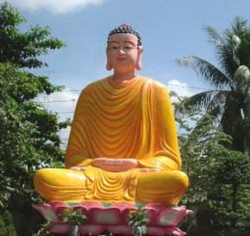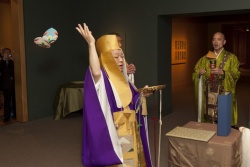The Tao and the Buddha
The Attraction
Buddhists are often attracted to the Tao and visa versa.
Both paths accent happiness through intellectual cultivation, and they both originated around the same time historically.
While Buddhists are often encouraged to read alternative ideas and religions, following another path while trying to be a Buddhist is specifically discouraged.
Early, close relationship
In China, Buddhism and Taoism, grew up together.
In fact, according to the Platform Sutra, transcribed from the words of the great Zen Master Hui Neng in the 8th century, Taoists attended least one, and probably many other, of his lectures.
Since Buddhism arrived in China well after Taoism had developed, the Chinese used familiar Taoist terms to describe similar Buddhist ideas.
This has led to countless poor translations of Sutras from Pali, Sanskrit and Tibetan into Chinese and caused a lot of misunderstandings. The Tao even has a similar writing style to Chinese Zen (actually called Ch'an in Chinese) writings.
Emptiness
The most common misunderstanding people have about the Tao is that "Emptiness" in the Tao has a similar meaning to "Emptiness" (Sunyata, Chinese: Kung, Japanese: Ku) in Buddhism.
This is because different words in Buddhism and Taoism were all translated as Emptiness in English.
Chinese character for 'empty' Several different Chinese characters are used for Emptiness in the Tao, but Chinese Buddhists mostly use the character on the right (pronounced 'Kung').
'Taoist Emptiness' is completely different to 'Buddhism Emptiness'. The Emptiness in the Tao is about restraint, patience, frugality, simplicity, lack of worldly desire etc.
These are all good things for Buddhists, but they have nothing whatever to do with Buddhist Emptiness, which is about the inaccuracy of our "externalist" perceptions of reality and the fictional objects that are created from that misunderstanding.
The Meeting?
Some Taoists believe that when Lao Tzu left LuoYang, he travelled to India to tutor the Buddha.
It's an interesting idea, but no serious historian would look at it because of timing, distance, language and credibility barriers to this possibility. Instead this legend probably grew out of the complex relationship between Taoism, Buddhism and Confucianism that existed in the 1st millennium.
This relationship is probably also responsible for the legend of Lao Tzu's meeting with Confucius that is detailed in the section on Lao Tzu.
If Zen Buddhism is interesting to you, About the Tao has a sister site, About Zen(http://www.aboutzen.info).
http://www.thetao.info/tao/buddha.htm

